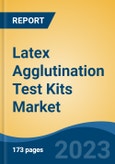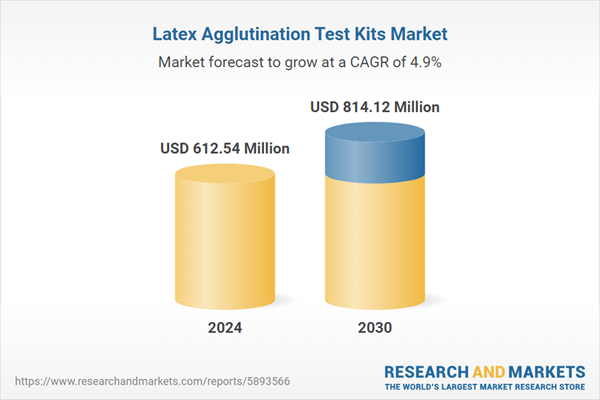Speak directly to the analyst to clarify any post sales queries you may have.
10% Free customizationThis report comes with 10% free customization, enabling you to add data that meets your specific business needs.
Key Market Drivers
Rising Incidence of Infectious Diseases
The global upsurge in infectious diseases is significantly fueling demand for diagnostic testing. Latex agglutination tests offer a rapid, easy-to-use, and affordable method for disease detection, making them highly attractive for healthcare systems seeking efficient diagnostic solutions, particularly during outbreaks or pandemics. One of the key advantages of these tests is their ability to deliver results within minutes, facilitating early diagnosis and timely medical intervention. This is especially crucial in managing fast-spreading or highly contagious diseases, where early detection can be instrumental in preventing widespread transmission.Latex agglutination tests are also well-suited for point-of-care use, enabling healthcare professionals to conduct diagnostics at the bedside, in outpatient settings, or in remote locations lacking advanced laboratory infrastructure. This portability and ease of use make them ideal for decentralized healthcare delivery. In the context of public health surveillance, these tests contribute valuable data for tracking disease prevalence and informing resource allocation strategies. The growing incidence of infectious diseases is further stimulating research and innovation to enhance the sensitivity, specificity, and scope of latex agglutination diagnostics.
Key Market Challenges
Interpretation Complexity
One of the primary challenges facing the Latex Agglutination Test Kits market is the complexity associated with result interpretation. Misinterpretation due to the nuanced nature of these tests can result in diagnostic inaccuracies, potentially leading to delayed or inappropriate treatments. Effective utilization of these tests requires healthcare professionals to undergo adequate training. In resource-limited settings where access to training is constrained, the adoption of latex agglutination kits may be restricted. Moreover, concerns around the consistency and reproducibility of test results - particularly when different professionals interpret outcomes differently - can undermine confidence in the technology.Complex interpretation may also complicate clinical decision-making, leading healthcare providers to opt for alternative diagnostic solutions perceived as more straightforward. The additional cost and time associated with training personnel can further act as a barrier to widespread adoption. Given their frequent use in point-of-care environments, where speed and simplicity are vital, any factor that detracts from these core benefits - such as interpretative complexity - can diminish their appeal. As a result, healthcare providers may favor diagnostic tools that offer clearer, faster, and more user-friendly outcomes.
Key Market Trends
Integration with Digital Solutions
The integration of latex agglutination test kits with digital health platforms is emerging as a transformative trend, enhancing the functionality and accessibility of these diagnostics. Real-time connectivity enables healthcare providers, patients, and stakeholders to access and share test results efficiently - particularly beneficial in point-of-care and remote settings. Digital integration also facilitates remote patient monitoring, allowing individuals to communicate test results with clinicians without requiring in-person visits, thereby streamlining care delivery and reducing costs. These platforms can capture and analyze vast datasets from test usage, generating insights into disease trends and supporting epidemiological research.Advanced digital tools can assist healthcare providers in interpreting test results through decision support algorithms, minimizing the likelihood of human error and improving diagnostic accuracy. Furthermore, telemedicine platforms benefit from this integration, as professionals can remotely review results and offer consultations, improving access to care in underserved areas. Patients, too, stand to benefit through improved engagement. Access to their test results via digital interfaces empowers them to take a more active role in managing their health, leading to better treatment adherence and improved outcomes.
Key Market Players
- Thermo Fisher Scientific, Inc.
- Biomérieux SA
- Biolegend, Inc.
- Eurofins Scientific
- Hardy Diagnostics
- Himedia Laboratories
- Biotec
- Creative Diagnostics
- ELITechGroup
- ARKRAY, Inc.
Report Scope:
In this report, the Global Latex Agglutination Test Kits Market has been segmented into the following categories, in addition to the industry trends which have also been detailed below:Latex Agglutination Test Kits Market, By Product Type:
- ELISA
- Indirect Fluorescent
- Hemagglutination Inhibition
- Serum Neutralization
Latex Agglutination Test Kits Market, By Test Type:
- Antibody Detection
- Antigen Testing
Latex Agglutination Test Kits Market, By Sample Type:
- Blood
- Urine
- Cerebrospinal Fluid
- Others
Latex Agglutination Test Kits Market, By End User:
- Hospital Pharmacies
- Retail Pharmacies
- Online Pharmacies
Latex Agglutination Test Kits Market, By Region:
- North America
- United States
- Canada
- Mexico
- Europe
- France
- United Kingdom
- Italy
- Germany
- Spain
- Asia-Pacific
- China
- India
- Japan
- Australia
- South Korea
- South America
- Brazil
- Argentina
- Colombia
- Middle East & Africa
- South Africa
- Saudi Arabia
- UAE
Competitive Landscape
Company Profiles: Detailed analysis of the major companies present in the Global Latex Agglutination Test Kits Market.Available Customizations:
With the given market data, the publisher offers customizations according to a company's specific needs. The following customization options are available for the report.Company Information
- Detailed analysis and profiling of additional market players (up to five).
This product will be delivered within 1-3 business days.
Table of Contents
Companies Mentioned
- Thermo Fisher Scientific, Inc.
- Biomérieux SA
- Biolegend, Inc.
- Eurofins Scientific
- Hardy Diagnostics
- Himedia Laboratories
- Biotec
- Creative Diagnostics
- ELITechGroup
- ARKRAY, Inc.
Table Information
| Report Attribute | Details |
|---|---|
| No. of Pages | 188 |
| Published | April 2025 |
| Forecast Period | 2024 - 2030 |
| Estimated Market Value ( USD | $ 612.54 Million |
| Forecasted Market Value ( USD | $ 814.12 Million |
| Compound Annual Growth Rate | 4.8% |
| Regions Covered | Global |
| No. of Companies Mentioned | 10 |









